OSU School of Entrepreneurship sends research team to Nicaragua
Thursday, March 31, 2016

A four-member research team of the School of Entrepreneurship at Oklahoma State University has ongoing research in Nicaragua as part of the school’s Global Entrepreneurship Project.
The research team consists of Craig Watters, director of the Riata Center for Entrepreneurship and International Chair for the School of Entrepreneurship; Nathan Richardson, associate professor, AIA and Riata Faculty Fellow; Jake Duke, doctoral candidate for the School of Entrepreneurship, and Adam Cobb, doctoral candidate for Natural Resource Ecology and Management. Areas of research analyze sustainable agricultural production and examine the entrepreneurial ecosystem development of Nicaragua.
Duke’s research measures the Nicaraguan high school students’ entrepreneurial abilities, including creative problem-solving skills, resource leveraging, risk management and adaption. Duke also examined the development of the entrepreneurial ecosystem by collecting longitudinal data on the density, connectivity, fluidity and diversity of the region.
“Our work in Nicaragua is creating and shaping a new generation of problem solvers and entrepreneurs that refuse to accept the world for what it is and strive to make it a better place,” Duke said.
Cobb’s agricultural production research focuses on ecological relationships in the Nicaraguan soil and the nutritional quality of its crops. His research plots of grain sorghum and cassava crops, bonded with AM fungi, have improved drought-tolerance and yield.
“Nicaragua has extreme dry and rainy seasons,” Cobb said. “This means the soils are subject to erosion from hot winds and flooding, which reduces beneficial microorganisms. The results from our research plots are extremely encouraging.”

The research team, in collaboration with OSU’s School of Architecture, also developed a structure for raising butterflies to assist non-profit organization Opportunity International in testing the viability of production and to demonstrate the potential impact of a butterfly initiative. This structure was part of a multi-year collaboration project to design and deploy small-scale architectural technologies to facilitate living condition improvements in developing countries.
“Our work in Nicaragua started as a social entrepreneurship effort,” Watters said. “We had five projects: entrepreneurship curriculum for a junior high school, curriculum for a new eco-hotel, soil improvement, butterfly farm development, and community development modeling. To achieve this, we went to the idea that entrepreneurship involved more than just business and we engaged students and faculty form many disciplines, all across campus. Entrepreneurship is the driver, the spark to light all of the disciplines into an economic fire for Nicaraguan growth and sustainability.”
Opportunity International is a 501 non-profit organization founded by Al Whittaker and David Bussau in 1971 and headquartered in Chicago. Opportunity International is composed of 49 organizations, 42 being microfinance institutions, operating in Africa, Eastern Europe, Central and East Asia and Latin America. The organization provides small business loans, insurance and grants to more than five million people in the developing world to date.
“Opportunity is doing really great work in Nicaragua,” Richardson noted. “They’ve got motivated people working within their organization, and I’ve seen them do a lot of good for the people in Nicaragua. It’s exciting to see their commitment to impacting people’s lives, and their work is more powerful than benevolence itself.”
